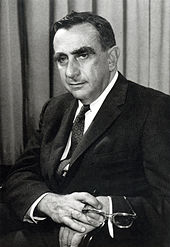Sundial (weapon)
This article needs additional citations for verification. (November 2024) |
Sundial was the codename of one of two massive nuclear bombs planned for testing by the University of California Radiation Laboratory, Livermore Branch as part of a classified[1][2] American weapons project in the early 1950s.[3] Announced by Edward Teller at a meeting of the General Advisory Committee of the Atomic Energy Commission, it was intended to have a yield of 10 gigatons of TNT, while its counterpart, Gnomon, was intended to have a yield of 1 gigaton.[4]
If built and detonated, Sundial would have created a fireball up to 50 kilometers (30 miles) in diameter, instantly igniting everything within 400 kilometers (250 miles) and causing a magnitude 9 earthquake. It was thought that the explosion would lead to an apocalyptic nuclear winter, drastically lowering global temperatures and contaminating water sources, resulting in mass fatalities, and/or human extinction.
Background
[edit]The world underwent rapid changes in the wake of World War II, including significant advancements in technology and warfare. The death toll from World War II reached some 60 million,[5][6][7] and the introduction of nuclear weapons created a new level of fear and uncertainty. After the United States developed and deployed its first atomic bombs, the Soviet Union detonated its first bomb in 1949, leading to a nuclear arms race during which the number of nuclear weapons escalated from nine in 1946 to 20,000 by 1960.

The first nuclear weapons to be developed relied solely on nuclear fission of plutonium or enriched uranium as their source of nuclear energy. Later came the development of thermonuclear weapons, commonly called hydrogen bombs, which use a pure fission or boosted fission primary stage to ignite nuclear fusion in a secondary stage, using the hydrogen isotopes deuterium and tritium as fuel.[8][9] Thermonuclear weapons can be made to be far more powerful than those that rely solely on fission. The Castle Bravo test in 1954 had a yield of 15 megatons; a thousand times more powerful than Little Boy, the bomb dropped on Hiroshima.[3]
Edward Teller had advocated for the development of a thermonuclear "super" bomb since the early days of the Manhattan Project, but there was little push to develop such weapons until after the Soviet Union tested its first atomic bomb in 1949. President Harry Truman directed the Atomic Energy Commission to work in developing thermonuclear weapons in 1950.[4][10] The first tests to utilize nuclear fusion came during Operation Greenhouse in 1951, which included the first trial of a boosted fission weapon in the Item test.[11] The first test of a true thermonuclear device, codenamed Ivy Mike, took place on November 1, 1952.[12] The explosion had a yield of 10.4 megatons and destroyed the small island of Elugelab where it was tested.[13] This first device, however, was too heavy to work as a deliverable weapon.[14] The first deployable thermonuclear weapon designs were tested during Operation Castle in 1954.[15]
Proposal and development
[edit]This section needs expansion. You can help by adding to it. (November 2024) |
At a meeting with the Atomic Energy Commission in 1954, following Operation Castle, Teller proposed the 10-gigaton Sundial device and the 1-gigaton Gnomon device. Others at the meeting were shocked by the proposal, and Isidor Isaac Rabi dismissed the idea as an "advertising stunt" rather than a serious proposal for a weapon.[4] If detonated at an altitude of 28 miles (45 km) the Sundial device could ignite fires across an area the size of France.[3] While neither device was ever built or tested, the Lawrence Livermore National Laboratory made plans to test a prototype Gnomon weapon during Operation Redwing in 1956.[3]
See also
[edit]References
[edit]- ^ "2013 FOIA Log" (PDF). Archived (PDF) from the original on 2016-03-04. Retrieved 2014-10-06.
- ^ "Case No. FIC-15-0005" (PDF). Archived (PDF) from the original on 2016-10-25. Retrieved 2016-10-25.
- ^ a b c d Wellerstein, Alex (2021-10-29). "The untold story of the world's biggest nuclear bomb". Bulletin of the Atomic Scientists. Archived from the original on August 27, 2023. Retrieved 2023-10-08.
- ^ a b c Wellerstein, Alex (12 September 2012). "In Search of a Bigger Boom". Restricted Data.
- ^ O'Brien, Joseph V. "World War II: Combatants and Casualties (1937–1945)". Obee's History Page. John Jay College of Criminal Justice. Archived from the original on 25 December 2010. Retrieved 28 December 2013.
- ^ White, Matthew. "Source List and Detailed Death Tolls for the Twentieth Century Hemoclysm". Historical Atlas of the Twentieth Century. Matthew White's Homepage. Archived from the original on 7 March 2011. Retrieved 20 April 2007.
- ^ "World War II Fatalities". secondworldwar.co.uk. Archived from the original on 22 September 2008. Retrieved 20 April 2007.
- ^ Sublette, Carey (8 May 1998). "Section 1.0 Types of Nuclear Weapons". nuclearweaponarchive.org. Retrieved 10 November 2024.
- ^ Sublette, Carey. "4.4 Elements of Thermonuclear Weapon Design". nuclearweaponarchive.org.
- ^ "Nuclear weapon - Fusion, Radiation, Superweapons | Britannica". www.britannica.com. 12 October 2024. Retrieved 10 November 2024.
- ^ "Operation Greenhouse". www.nuclearweaponarchive.org. 2 August 2003. Retrieved 10 November 2024.
- ^ "Operation Ivy". www.nuclearweaponarchive.org. 14 May 1999. Retrieved 10 November 2024.
- ^ Lamm, Joanne (28 October 2010). "The Island is Missing!". www.army.mil. United States Army. Retrieved 10 November 2024.
- ^ Wellerstein, Alex (January 8, 2016). "A Hydrogen Bomb by Any Other Name". The New Yorker. Retrieved 10 November 2024.
- ^ "Operation Castle". 17 May 2006. Retrieved 10 November 2024.
